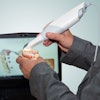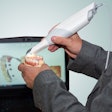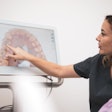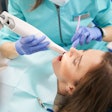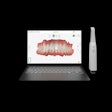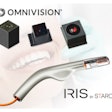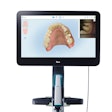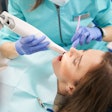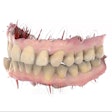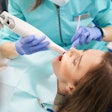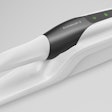
If you use an intraoral scanner for digital impressions of a patient's upper jaw, do you run into difficulties with palatal vault heights or arch widths?
While there have been studies on digital impressions for restorations, researchers from China wanted to discover if different palatal vault heights or arch widths affected the accuracy of intraoral digital impressions. Their study was published in PLOS One (July 6, 2016).
"It was feasible to use the intraoral scanner to obtain digital impressions for whole upper jaws," wrote the authors, led by Ning Gan of the department of prosthodontics at Ninth People's Hospital in Shanghai. "Wider dental arch contributed to lower precision of an intraoral digital impression."
Soft tissues and upper dentition
Digital impressions are the first step of CAD/CAM in the office. The use of CAD/CAM has expanded to single crowns, multiunit fixed dental prostheses, oral implants, and complete denture prosthodontics.
“Wider dental arch contributed to lower precision of an intraoral digital impression.”
Intraoral digital impressions have proved to be efficient in previous studies, the study authors noted. These past studies have also shown that patients prefer the digital impression process to the conventional method.
In the current study, the researchers wanted to learn if intraoral scans were an appropriate technique for impressions of a patient's upper jaw. They scanned palatal soft tissues and full upper dentitions in 32 patients (18 women, 14 men). They also investigated the effect of different palatal vault height and arch width on the accuracy of these impressions.
Coming into the study, the authors proposed that it would be feasible to obtain digital impressions for whole upper jaws by using an intraoral scanner, and they hypothesized that the palatal vault height or arch width would not influence the accuracy of the impression.
The 32 patients (ages 21 to 41; average age 27) all had good oral hygiene, a complete maxillary dental arch except missing third molars, and intact hard and soft tissues, including treated teeth decay and healed teeth extraction sockets. None of the participants had oral implants, advanced periodontitis, or obvious teeth mobility.
The researchers scanned each participant's entire upper jaw, including full dentition and palatal soft tissues, with an intraoral scanner (Trios Pod, 3Shape). They began scanning at the second molar in the first quadrant and stopped at the second molar in the second quadrant. For the palatal soft tissues, scanning began with the palatal sides of upper central incisors and progressed in a zigzag manner, ending at the level of the distal end of the second molars. Average scanning time was just under five minutes.
Researchers defined arch width as the "distance in a straight line between the mesiodistal center of the palatal gingival margin of the left and right first molars." Palatal vault height was defined as the vertical distance from the occlusal plane to the median line of the palate in the position connecting the mesiodistal center of the left and right first molars. Researchers measured each width and palatal vault height three times and calculated a mean value from those measurements (see table below).
| 3D comparison deviations between digital and convention impressions | |||
| Mean deviation between techniques | Positive deviation | Negative deviation | |
| Palatal soft tissues | 130.5 ± 33.95 µm | 185.84 ± 51.11 µm | 75.23 ± 25.86 µm |
| Full upper dentitions | 80.01 ± 17.78 µm | 96.24 ± 22.46 µm | 63.78 ± 16.18 µm |
The authors also compared, on the same patient, one digital impression with another. They found a precision of 55.26 ± 11.21 µm for palatal soft tissues and 59.52 ± 11.29 µm for full dentitions. They defined precision as the comparison between repeated digital scanning models obtained from one volunteer.
Arch width was not a significant influence on the "trueness" of digital impressions for full dentitions. The authors defined "trueness" as a comparison between digital impression served as test model and a conventional impression served as reference model of the same volunteer.
The researchers found a statistically significant difference when they compared the trueness of digital impressions for the palatal soft tissues with that of a full-upper dentitions (p < 0.001).
Vault height effect
Previous studies have found that patients prefer the digital process for impressions, because this method is quicker and more comfortable than traditional impressions.
In this study, the researchers found that while it was feasible to use the intraoral scanner for whole upper jaws and that palatal vault height has no effect on accuracy, a patient's arch width may influence the accuracy of these digital impressions.
"Trueness of digital impressions for full dentitions was better than that for palatal soft tissues. Precision of digital impressions for palatal soft tissues was a little better than that for full dentitions," the authors concluded.
